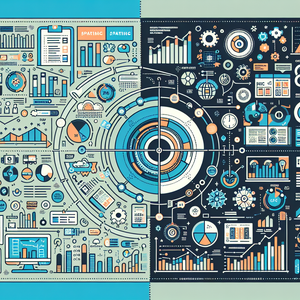The Future of Prototyping: AI-Driven 3D Models

The integration of AI into the prototyping process signifies a paradigm shift in product design and development. Traditional prototyping typically entails a protracted cycle of drafting, testing, and revising models. AI streamlines these stages by employing machine learning algorithms capable of analyzing vast datasets to create optimized models that adhere to specific criteria more efficiently than human designers alone. One of the standout advantages of AI-driven prototyping is its capacity to generate multiple design iterations rapidly. For instance, AI algorithms can evaluate parameters like material properties, structural integrity, and aesthetic appeal, producing a variety of models that meet these constraints. This capability not only accelerates the design process but also empowers designers to explore more creative solutions that may have previously gone unnoticed.
Enhancing Creativity and Innovation
AI does more than just expedite workflows; it also enhances creativity. By automating routine tasks and providing data-driven insights, designers can focus on the more imaginative aspects of their work. For example, AI can analyze user feedback and market trends, suggesting design directions that resonate with target audiences. This collaborative relationship between human creativity and AI efficiency fosters an environment ripe for innovation.
Time and Cost Savings
The potential time and cost savings associated with AI-driven 3D models are profound. In industries such as automotive manufacturing, where traditional prototyping phases can extend over months, AI significantly shortens these timelines. Ford Motor Company exemplifies this trend by utilizing AI algorithms to simulate and test vehicle components before physical prototypes are even produced. This approach not only reduces prototyping time but also minimizes material waste, resulting in substantial cost savings. Furthermore, in the gaming industry, companies like Epic Games are harnessing AI to create realistic environments and characters. By automating aspects of model creation, developers can channel more resources into storytelling and gameplay mechanics, enhancing the overall player experience while maintaining production efficiency.
Real-World Examples of AI in Prototyping
Several companies are at the forefront of integrating AI into their prototyping processes, showcasing the technology's transformative potential: 1. NVIDIA: Renowned for its graphics processing units, NVIDIA has developed AI tools that assist in generating 3D models and environments for gaming and virtual reality applications. Their Omniverse platform fosters real-time collaboration among creators, with AI facilitating the generation of complex assets and animations. 2. Autodesk: This software powerhouse has infused AI into its design tools like Fusion 360. The software leverages machine learning to suggest design improvements and automate mundane tasks, freeing engineers and designers to concentrate on innovation rather than routine adjustments. 3. Siemens: Operating in the realm of industrial automation, Siemens employs AI to optimize the design of machinery and equipment. By simulating performance and identifying potential issues during the prototyping phase, Siemens accelerates product development while enhancing overall quality.
Challenges Ahead
Despite the promising benefits of AI-driven 3D modeling, several challenges persist. A primary concern is the necessity for high-quality data to train AI algorithms effectively. Insufficient or biased data can lead to flawed models, posing significant risks in precision-critical industries such as aerospace or medical device manufacturing. Additionally, there remains an ongoing debate about the balance between human creativity and AI efficiency. While AI can produce rapid iterations, the unique insights and emotional depth contributed by human designers are irreplaceable.
The future of prototyping is undeniably intertwined with advancements in AI-driven 3D modeling. As industries continue to adopt this technology, the potential for increased efficiency, reduced costs, and enhanced creativity will revolutionize how products are conceived and developed. While challenges exist, the success stories of companies leveraging AI's capabilities illustrate that the advantages outweigh the hurdles. Looking forward, it is evident that AI will play a pivotal role in shaping the next generation of prototyping, empowering industries to innovate at unprecedented speeds and with remarkable precision. As technology continues to evolve, companies that embrace AI-driven prototyping will undoubtedly find themselves at the forefront of their respective fields, ready to tackle the challenges of tomorrow.
AI/ML Engineer - 3D Modeling Applications
NVIDIA, Autodesk, Epic Games
Core Responsibilities
Develop machine learning algorithms to optimize 3D modeling processes for various industries.
Collaborate with designers and engineers to integrate AI capabilities into existing design software.
Conduct experiments to refine algorithms based on user feedback and performance metrics.
Required Skills
Proficiency in Python, TensorFlow, or PyTorch.
Strong understanding of computer graphics and 3D modeling techniques.
Experience with data analysis and visualization tools.
3D Design Engineer - AI Integration
Siemens, Ford Motor Company, Boeing
Core Responsibilities
Create and refine 3D models using AI-driven tools to enhance product design.
Analyze user requirements and market trends to inform the design process.
Collaborate with cross-functional teams to ensure designs meet technical specifications and usability standards.
Required Skills
Proficient in CAD software (e.g., SolidWorks, Autodesk Inventor).
Familiarity with AI tools and machine learning concepts.
Strong problem-solving skills and attention to detail.
UX/UI Designer - AI-Driven Prototyping Tools
Autodesk, Epic Games, Unity Technologies
Core Responsibilities
Design user interfaces for AI-powered prototyping applications, ensuring usability and aesthetic appeal.
Conduct user research to gather feedback and iterate on design concepts.
Work with developers to implement and test UI designs in the final product.
Required Skills
Expertise in design software such as Adobe XD, Sketch, or Figma.
Understanding of user experience principles and human-computer interaction.
Basic knowledge of front-end development (HTML/CSS/JavaScript) is a plus.
Product Manager - AI-Enhanced Design Software
Autodesk, Siemens, NVIDIA
Core Responsibilities
Lead the development of AI-driven tools for 3D modeling and prototyping, from concept to launch.
Collaborate with engineering, design, and marketing teams to define product vision and strategy.
Monitor industry trends and competitor activities to identify opportunities for innovation.
Required Skills
Strong background in product management, preferably in tech or design software.
Excellent communication skills to liaise between technical and non-technical teams.
Understanding of AI technologies and their applications in design.
Data Scientist - Design Optimization
Ford Motor Company, Epic Games, Autodesk
Core Responsibilities
Analyze datasets related to user interactions and design performance to inform AI model improvements.
Develop predictive models that guide design choices and enhance user experience in 3D applications.
Present findings to stakeholders to drive data-driven decisions in product development.
Required Skills
Proficiency in statistical analysis and machine learning techniques.
Experience with data visualization tools (e.g., Tableau, Power BI).
Strong programming skills in R or Python, with knowledge of SQL for data extraction.


